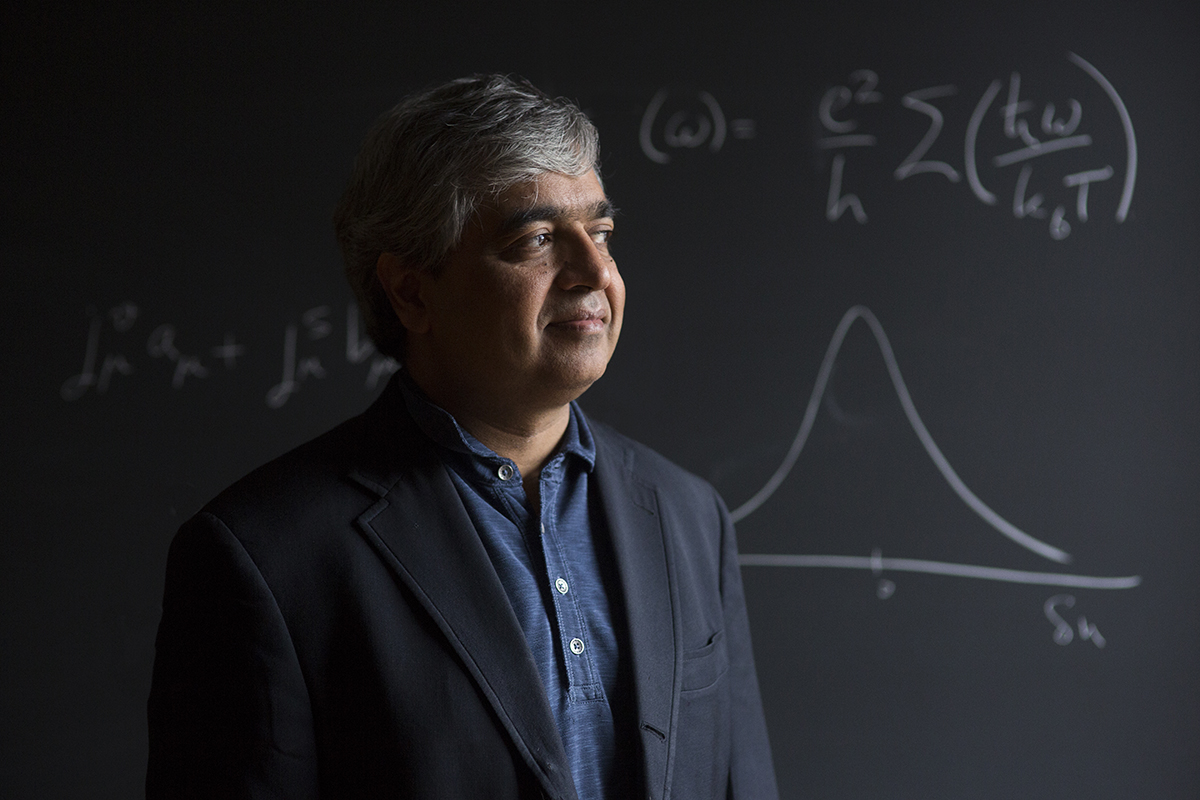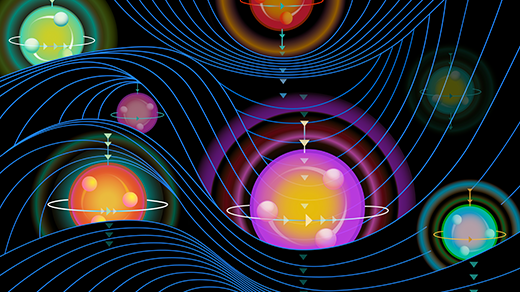Taming Superconductors With String Theory

String theory was devised as a way to unite the laws of quantum mechanics with those of gravity, with the goal of creating the vaunted “theory of everything.”
Subir Sachdev is taking the “everything” literally. He’s applying the mathematics of string theory to a major problem at the other end of physics — the behavior of a potentially revolutionary class of materials known as high-temperature superconductors.
These materials are among the most promising and the most perplexing. Unlike regular superconductors, which need to be cooled almost to absolute zero (–273.15 degrees Celsius) to pass a frictionless current of electricity, high-temperature superconductors yield the same remarkable performance under more accommodating conditions. Since the first high-temperature superconductor was discovered in 1986, physicists have found other materials that exhibit superconductivity at successively higher temperatures, with the current record standing at –70 degrees Celsius.
This progress has occurred despite the fact that physicists don’t understand how these superconductors work. Broadly speaking, many condensed-matter physicists study how electrons — the carriers of electrical current — move through a given material. In an ordinary conductor like copper or gold, the electrons flow through a lattice formed by the copper or gold atoms. In an insulator like diamond, electrons tend to stay put. In superconductors, electrons move through the underlying atomic lattice with no energy loss at all. For three decades, physicists have been unable to develop a comprehensive theory that explains how electrons in high-temperature superconductors behave.
A particularly interesting question is how the behavior of the material changes with temperature — in particular, how conductors transition from ordinary to super as the temperature drops. Scientists call this a “quantum phase change,” with the two phases being the property of the material on either side of the transition temperature.
Sachdev, a condensed-matter physicist at Harvard University, explains that the challenge is one of scale. A typical chunk of material has trillions upon trillions of electrons. When those electrons interact with one another — as they do in superconductors — they become impossible to keep track of. In some phases of matter, physicists have been able to overcome this scale issue by modeling swarms of electrons as “quasiparticles,” quantum excitations that behave a lot like individual particles. But the quasiparticle strategy doesn’t work in high-temperature superconductors, forcing physicists to look for another way to impose collective order on the behavior of electrons in these materials.
In 2007 Sachdev had a startling insight: He realized that certain features of string theory correspond to the electron soup found in high-temperature superconductors. In the years since, Sachdev has developed models in string theory that offer ways to think about the electron behavior in high-temperature superconductors. He’s used these ideas to design real-world experiments with materials like graphene — a flat sheet of carbon atoms — which have properties in common with the materials that interest him.
In a forthcoming paper in Science, he and his collaborators use methods borrowed from string theory to correctly predict experimental results related to the flow of heat and electrical charge in graphene. Now he hopes to apply his insights to high-temperature superconductors themselves.
Quanta Magazine spoke with Sachdev about how the electrons in high-temperature superconductors are related to black holes, his recent success with graphene, and why the biggest name in condensed-matter physics is skeptical that the string-theory approach works at all. An edited and condensed version of the interview follows.
QUANTA MAGAZINE: What’s going on inside a high-temperature superconductor?
SUBIR SACHDEV: The difference between old materials and the new materials is that in older materials, electrons conduct electricity independent of one another. They obey the exclusion principle, which says electrons can’t occupy the same quantum state at the same time and that they move independently of one another. In the new materials that I, and many others, have been studying, it’s clear that this independent-electron model fails. The general picture is that they move cooperatively and, in particular, they’re entangled — their quantum properties are linked.
This entanglement makes high-temperature superconductors much more complicated to model than regular superconductors. How have you been looking at the problem?
Generally I approach this through the classification of the quantum phases of matter. Examples of simple quantum phases are simple metals like silver and gold, or simple insulators like diamonds. Many of these phases are well-understood and appear everywhere in our daily lives. Since we discovered high-temperature superconductors, and many other new materials, we’ve been trying to understand the other physical properties that can emerge when you have trillions of electrons obeying quantum principles and also interacting with each other. At the back of my mind is the hope that this broad attack on classifying quantum phases of matter will lead to a deeper understanding of high-temperature superconductors.
How far have you gotten?
There has been great progress in understanding the theory of quantum phase transitions, which involves taking two phases of quantum matter that are very different from each other and adjusting some parameter — say, pressure on a crystal — and asking what happens when the material goes from one phase to the other. There has been a huge amount of progress for a wide class of quantum phase transitions. We now understand many different kinds of phases we didn’t know existed before.
But a full theory of how electrons behave in high-temperature superconductors has been difficult to develop. Why?
If you have a single electron moving through a lattice, then you really only need to worry about the different positions that electron can occupy. Even though the number of positions is large, that pretty much is something you can handle on a computer.
But once you start talking about many electrons, you have to think about it very differently. One way to think about it is to imagine that each site on the lattice can be either empty or full. With N sites it’s 2N, so the possibilities are unimaginably vast. In this vast set of possibilities, you have to classify what are reasonable things an electron would tend to do. That in a nutshell is why it’s a difficult problem.
Returning to phase transitions, you’ve spent a lot of time studying what happens to a high-temperature superconductor when it grows too warm. At this point, it becomes a so-called “strange metal.” Why would understanding strange metals help you to understand high-temperature superconductors?
If you start with a superconductor and raise the temperature, there’s a critical temperature at which the superconductivity disappears. Right above this temperature you get a type of metal that we call a strange metal because many of its properties are very different from ordinary metals. Now imagine reversing the path, so that the phase of a system is changing from a strange-metal state to a superconducting state as it goes below the critical temperature. If we’re going to determine the temperature at which this happens, we need to compare the energies of the quantum states on either side of the critical temperature. But strange metals look strange in every respect, and we have only the simplest models for their physical properties.
What makes strange metals so different from other unique quantum phases?
In certain phases, [quantum] excitations generally behave like new emergent particles. They are quasiparticles. Their inner structure is very complicated, but from the outside they look like ordinary particles. The quasiparticle theory of many-body states pretty much applies to all states we’ve discovered in the older materials.
Strange metals are one of the most prominent cases we know where quasiparticle theory fails. That’s why it’s so much harder to study them, because this basic tool of many-body theory doesn’t apply.
You had the idea that string theory might be useful for understanding quantum phases that lack quasiparticles, like strange metals. How is string theory useful in this setting?
From my point of view, string theory was another powerful mathematical tool for understanding large numbers of quantum-entangled particles. In particular, there are certain phases of string theory in which you can imagine that the ends of strings are sticking to a surface. If you are an ant moving on the surface, you only see the ends of the string. To you, these ends look like particles, but really the particles are connected by a string that goes to an extra dimension. To you, these particles sitting on the surface will appear entangled, and it is the string in the extra dimension which is entangling the particles. It’s a different way of describing entanglement.
Now you could imagine continuing that process, not just with two electrons, but with four, six, infinitely many electrons, looking at the different entangled states the electrons can form. This is closely connected to the classification of phases of matter. It’s a hierarchical description of entanglement, where each electron finds a partner, and then the pairs entangle with other pairs, and so on. You can build this hierarchical structure using the stringy description. So it is one approach to talking about the entanglement of trillions of electrons.
This application of string theory to strange metals has some interesting implications. For instance, it’s led you to draw connections between strange metals and the properties of black holes. How do you get from one to the other?
In the string-theory picture, [changing the density of electrons] corresponds to putting a charge on a black hole. Many people have been studying this in the last five years or so — trying to understand things about strange metals from the properties of charged black holes. I have a recent paper in which I actually found a certain artificial model of electrons moving on a lattice where many properties precisely match the properties of charged black holes.
I’ve read that Philip Anderson, considered by many people to be the most-influential living condensed-matter physicist, is skeptical that string theory is really useful for understanding strange metals. Do you know if that’s true?
I think that’s correct. He’s told me himself that he doesn’t believe any of this, but, you know, what can I say, he’s a brilliant man with his own point of view. I would say that when we first proposed the idea in 2007, it certainly sounded crazy. A lot of progress has been made since then. I have a new paper with Philip Kim and others where it turns out that with graphene, which is a slightly less-strange metal, many of the methods inspired by string theory have led to quantitative predictions that have been verified by experiments.
I think that’s been one of the best successes of the string-theory methods so far. It literally works; you can get the numbers right. But graphene is a simple system, and whether these methods are going to work for high-temperature superconductors hasn’t yet been proven.
Could you say more about why Anderson might be skeptical of the approach you’ve taken?
If you go back and actually look at string-theory models, on the surface they look very different from the kinds of models you need for high-temperature superconductors. You look at the stringy models and their constituents, and it appears absurd that these are connected to the constituents of the high-temperature superconductors. But if you take the point of view that, OK, I’m not literally saying this model is going to be found in [high-temperature superconductors], this is just a model that helps me make progress on difficult issues, like how do materials without quasiparticles behave, string theory gives you examples of one of these materials that’s reliably solvable.
How literally are you using string theory? Is it a direct application, or are you drawing inspiration from it?
It’s closer to the inspiration side of things. Once you’ve solved the model, it gives you a lot of insight into other models that you may not be able to solve. After six or seven years of work closer to the string-theory side, we think we’ve learned a lot. For us the next step appears to be working in more realistic systems using inspiration we got from more solvable models.
How might the string-theory models, plus the work on graphene, put you in a position to understand the properties of high-temperature superconductors?
As you change the density of electrons in high-temperature superconductors, there’s a much more dramatic change in which the electrons go from a regime where it seems only a few electrons are mobile to one where all electrons are mobile. We’re understanding that there’s a special point called the optimal density where there seems to be a dramatic change in the quantum state of electrons. And right near this point is where the strange metal is also observed. We’re trying to work out microscopic theories of this special point where the quantum state changes, and stringy models can teach us a lot about such quantum-critical points. Once we have the full framework, we’re hopeful and optimistic that we can take many of the insights from graphene and apply them to this more complicated model. That’s where we are.
This article was reprinted on ScientificAmerican.com.



